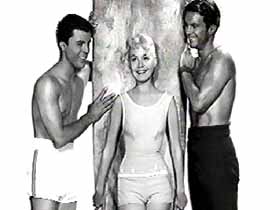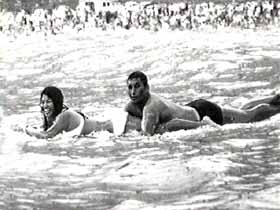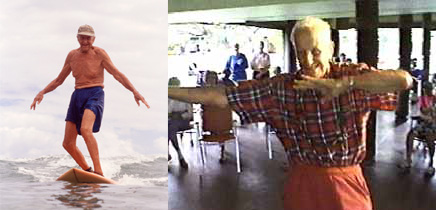FROM POLYNESIA, WITH LOVE
The History of Surfing From Captain Cook to the Present
By Ben Marcus
| From Polynesia, with Love: 3 pages [1] [2] [3] |
Gidget and the Era of Modern Surfing
 In the 1930s, '40s and '50s, there were adventurous men and women-- like Ball, Kekai, Kelly, Cole, Van Dyke, Fletcher and Napoleon-who followed in the noble tradition of Duke Kahanamoku and the ancient Hawaiians. Then, along came a young surfer girl named Gidget who was immortalized in a book by her father and then in the movie that bears her name. Gidget the movie brought surfing to international attention for the first time. Then came the Beach Blanket Bingo movies, the driving surf guitar of Dick Dale, the sweet surf harmonies of the Beach Boys, and, by the mid-sixties, everybody was going surfing. Where once there had been dozens of people surfing, now there were thousands. Surfboards were made of plastic and mass-produced, a far cry from the ceremonial chants and hand-carved hardwoods of ancient Hawai'i.
In the 1930s, '40s and '50s, there were adventurous men and women-- like Ball, Kekai, Kelly, Cole, Van Dyke, Fletcher and Napoleon-who followed in the noble tradition of Duke Kahanamoku and the ancient Hawaiians. Then, along came a young surfer girl named Gidget who was immortalized in a book by her father and then in the movie that bears her name. Gidget the movie brought surfing to international attention for the first time. Then came the Beach Blanket Bingo movies, the driving surf guitar of Dick Dale, the sweet surf harmonies of the Beach Boys, and, by the mid-sixties, everybody was going surfing. Where once there had been dozens of people surfing, now there were thousands. Surfboards were made of plastic and mass-produced, a far cry from the ceremonial chants and hand-carved hardwoods of ancient Hawai'i.
Surfing grew relatively slowly from 1779 through 1960, but with growing media exposure over 40 years, surfing has grown from a clique sport to a vast industrial complex. Where Doc Ball and LeRoy Grannis and a few others took photos of the scene and published books, now there are dozens of surf magazines and websites all around the world. The surf video has replaced the touring surf movie, and the easy access to quality video equipment has resulted in a surfing world that is relentlessly recorded and packaged. Where kings and commoners once competed in the surf, risking status, property, life and limb, now there is a multi-million dollar international professional surfing circuit, with a tour that covers the globe from Hawai'i to South Africa and back to Tahiti.
 There are still beach boys at Waikiki, and Rabbit Kekai remains one of them. Both Dick Dale and The Beach Boys (band) are still touring, performing classic surf anthems. Woody Brown, John Kelly, Anona Napoleon, Peter Cole and Fred Van Dyke are still "stoked" to be out surfing, and Eve Fletcher continues to be one of the regular veterans at San Onofre, where four generations of surfers share the water. What was a thriving part of the Hawaiian culture in 1778 is now a thriving part of world culture in the 21st Century. Despite the commercialism, surfing continues to provide enjoyment and a special union with nature for millions throughout the globe. Surfing is an element of traditional Hawaiian culture that, unlike many other aspects of ancient Hawaiian life, has survived into modern times. In the true aloha spirit of giving with grace and love, surfing is truly a gift from Polynesia to the world.
There are still beach boys at Waikiki, and Rabbit Kekai remains one of them. Both Dick Dale and The Beach Boys (band) are still touring, performing classic surf anthems. Woody Brown, John Kelly, Anona Napoleon, Peter Cole and Fred Van Dyke are still "stoked" to be out surfing, and Eve Fletcher continues to be one of the regular veterans at San Onofre, where four generations of surfers share the water. What was a thriving part of the Hawaiian culture in 1778 is now a thriving part of world culture in the 21st Century. Despite the commercialism, surfing continues to provide enjoyment and a special union with nature for millions throughout the globe. Surfing is an element of traditional Hawaiian culture that, unlike many other aspects of ancient Hawaiian life, has survived into modern times. In the true aloha spirit of giving with grace and love, surfing is truly a gift from Polynesia to the world.

 In the 1930s, '40s and '50s, there were adventurous men and women-- like Ball, Kekai, Kelly, Cole, Van Dyke, Fletcher and Napoleon-who followed in the noble tradition of Duke Kahanamoku and the ancient Hawaiians. Then, along came a young surfer girl named Gidget who was immortalized in a book by her father and then in the movie that bears her name. Gidget the movie brought surfing to international attention for the first time. Then came the Beach Blanket Bingo movies, the driving surf guitar of Dick Dale, the sweet surf harmonies of the Beach Boys, and, by the mid-sixties, everybody was going surfing. Where once there had been dozens of people surfing, now there were thousands. Surfboards were made of plastic and mass-produced, a far cry from the ceremonial chants and hand-carved hardwoods of ancient Hawai'i.
In the 1930s, '40s and '50s, there were adventurous men and women-- like Ball, Kekai, Kelly, Cole, Van Dyke, Fletcher and Napoleon-who followed in the noble tradition of Duke Kahanamoku and the ancient Hawaiians. Then, along came a young surfer girl named Gidget who was immortalized in a book by her father and then in the movie that bears her name. Gidget the movie brought surfing to international attention for the first time. Then came the Beach Blanket Bingo movies, the driving surf guitar of Dick Dale, the sweet surf harmonies of the Beach Boys, and, by the mid-sixties, everybody was going surfing. Where once there had been dozens of people surfing, now there were thousands. Surfboards were made of plastic and mass-produced, a far cry from the ceremonial chants and hand-carved hardwoods of ancient Hawai'i.

